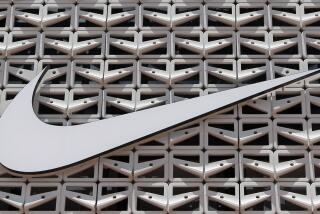Nissan Posts Its First-Ever Loss--$178 Million : Autos: The setback in the company’s fiscal first half underscores the problems faced by Japanese car makers.
- Share via
TOKYO — In its first loss in 41 years as a public concern, Nissan Motor Co. said Monday that it lost $178 million in the first half of its current fiscal year and, for the first time ever, will not pay a midyear dividend to shareholders.
The unprecedented loss underscores the difficulties Japanese car companies are having in coping with declining auto sales at home, a sluggish world market and a shrinking gap between them and their U.S. rivals in cost and quality.
Nissan has fared worse than its Japanese rivals in holding onto market share and is additionally burdened by heavy investments in new factories at home and abroad.
“The results are a disappointment to management and to investors,” Nissan Executive Vice President Atsushi Muramatsu said at a news conference. He blamed the loss on sluggish markets worldwide.
Muramatsu promised a turnaround by next summer, but the company projected a loss of about $163 million for its fiscal year ending next April. The company also said the first-half loss might be larger when results from subsidiary companies are included.
The company said its biggest problem in the first half was a 20% drop in car sales in Japan, which caused revenue to fall 8.5% to $15.6 billion.
The Japanese market in general is slow, and virtually all Japanese auto makers are losing market share in Europe and the United States this year. Mazda Motors, concerned about its declining market share in the United States, last week canceled plans for a U.S. Amati luxury car division. And Honda Motor Co. recently canceled its sponsorship of Formula One auto racing.
Japanese companies have increased manufacturing overseas to head off pressure against auto exports, but the decline in the Japanese market has saddled them with excess capacity at home.
Nissan’s problems go beyond the sudden downturn in the Japanese economy. The company is losing market share relative to other Japanese auto makers at home and abroad, and its balance sheet is far weaker than those of its key competitors.
Nissan’s cash position has not been as strong as its rivals, and it has had to borrow at high interest rates to carry out its aggressive program to build and modernize factories around the world in order to put more of its models on the market.
Nissan opened a highly automated plant last spring on the southern island of Kyushu, where car bodies glide down the assembly line on independent, motor-driven dollies that rise and tilt to make the worker’s job easier and increase the factory’s flexibility. The price tag for this ultramodern factory--a cool $800 million. Nissan is also building new factories in Mexico, the United States and the United Kingdom.
The rising value of the yen has also eaten away at Nissan’s profit and has reduced its competitiveness relative to U.S. auto makers. Some analysts believe that, with the exception of Toyota, the $500 per car cost advantage Japanese auto makers once enjoyed may be gone.
And quality may no longer be the huge advantage to Japanese makers it once was. In the race to add new models to their lineup, many Japanese auto makers skimped on product testing, according to Fumio Matsuda, a former Nissan quality control expert who is now president of the Japan Automobile Consumers Union. Matsuda estimated the cost of settling consumer complaints and lawsuits at Nissan to be in the hundreds of millions of dollars, up sharply from just a few years ago.
Earlier this year, Nissan had hoped that it could solve its profit problems, cut time pressure on engineers and at the same time ease trade frictions by selling fewer cars in fewer model variations and at higher prices. The only problem with the plan was that Toyota Motor Corp. didn’t follow Nissan’s lead. Instead of higher profit, Nissan found itself losing both money and market share.
Nissan is also hurting from having the wrong product mix, said Peter Boardman, an analyst at the Tokyo office of the UBS Phillips & Drew brokerage house. When luxury cars were in vogue, Nissan’s lineup was strong in mid-level cars. Now that Nissan has a strong line of luxury cars, said Boardman, there are few buyers for the vehicles in the key domestic market.
In the United States, most growth has been in vans, small trucks and recreational vehicles, sectors in which Nissan is weakest.
Despite its mistakes, Nissan is hardly a basket case. Analysts expect the company’s heavy investment in new technology and factories to eventually bring handsome returns. Some analysts argue that its large production facilities in Mexico and the United States will put Nissan in a good position to boost market share in the West if the proposed North America Free Trade Agreement is implemented.
Nissan also recently began production in the United States of the popular Altima, a car expected to compete with Ford’s Taurus and Toyota’s Camry.
The company is also undergoing an aggressive cost-cutting campaign that includes reducing its work force by 7%. It is also cutting back the number of variations it offers for each car model to save on production costs.
These measures may pull Nissan out of its slump, but for the moment, the company hardly represents the powerful force U.S. author David Halberstam profiled six years ago in the “The Reckoning,” his 750-page chronicle of the changing fortunes of American and Japanese auto makers. Ironically, Ford Motor Co., which Halberstam profiled as representative of the declining U.S. industry, has enjoyed a revival of late.
Nissan’s Net
Nissan Motor Co. annual profit and loss. 1988: $314 million 1989: $517 million 1990: $691 million 1991: $634 million 1992: $439 million Fiscal 1993*: $163-million loss
* Projected for full year; loss for first six months was $178 million.
Source: Company reports






